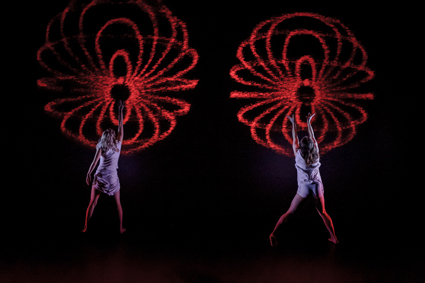Micro/macro dances of light & matter
Ben Brooker: ADT, Multiverse

Multiverse, ADT
photo Chris Herzfeld
Multiverse, ADT
It has taken only about a century, a mere blink of the cosmic eye, for physicists to condense the principles that regulate the behaviour of all forces and forms of matter in the universe into a series of fundamental laws and theories. The pursuit of a master equation, a ‘theory of everything’ that would unite all of these hypotheses, is among the major scientific projects of the current era.
The best candidate we presently have for such a unifying theory—one that may be verified within the next few years by particle acceleration and detection experiments at the CERN laboratory—is String Theory, a theoretical framework that replaces ultramicroscopic point particles with one-dimensional strings. The American theoretical physicist Brian Greene has described these strings as “dancing filaments of energy.”
It is, no doubt, this kinematic quality [kinematics: the motion of points, bodies and systems without consideration of the causes. Eds] which attracted ADT’s Garry Stewart to the idea of exploring theoretical physics through contemporary dance. While a Thinker in Residence at Deakin University’s Motion.Lab in 2012–2013, Stewart began to develop Multiverse, a work exploring the microscopic interactions of matter and energy via the macroscopic intermingling of live bodies and 3D stereoscopy. For the completed work, which features ADT dancers Kimball Wong, Samantha Hines and Matte Roffe, audience members don 3D glasses just as they might at a new action or family movie. They are also met by a warning, displayed in large, friendly letters prior to the start of the show: “Please look away if the 3D starts to make you feel sick.”
It comes as something of a relief that Multiverse does not induce nausea in this writer and, furthermore, does little to remind him of the biliously excessive uses to which 3D technology is so often put in contemporary cinema. CG animation is, however, as central to Multiverse as it is to a Michael Bay blockbuster. We see a computer-generated image—a sort of orange-coloured galaxy in cross-section that appears to loom out of the darkness into the very centre of the space—before we see a human body. When one does emerge, the choreography, mirroring the violent agitation of subatomic particles, is convulsive, the motion of arms and legs seeming to be propelled from external rather than internal energies. A second dancer appears (it is often difficult to tell them apart) and the pair shudders around beneath the 3D object as it continues to expand and revolve. The effect is bettered by a later sequence in which Hines and Roffe seem to wrench apart a dense matrix of red points of light, the dancers suddenly godlike in their easy manipulation of what may be a star field or a cloud of electrons.
The graphic design (Kim Vincs, Daniel Skovli, Simeon Taylor, Kieren Wallace, Bobby Lin, John McCormick and Peter Divers) impatiently cycles through multiple geometric shapes and topographies, constantly playing with both our perception of depth and our sense of where the work is situating us at any given moment—embedded within the nanoscopic universe or projected into the garish mise-en-scènes of alien cityscapes and spaceports. It is not always clear which of these planes Stewart is attempting to invoke.
In a post-show Q & A, Stewart said that Multiverse’s visual language is an invented one, a reflection of his desire to eschew the typical aesthetics of TV science programs. The result is, however, not so much original as an original hybrid. Brendan Woithe’s electronic soundscape, for example, clearly channels Vangelis’ Blade Runner score and there are moments when the graphics veer uncomfortably close to IMAX documentary-style blandness or, worse, the visual banality of computer screensavers. In this schema, the dancers are occasionally swamped, their demanding floor work unable to hold our attention over the show’s most persuasive optical artifices. But they are assisted by Catherine Ziersch’s light-reflecting costumes and the use of registered video which partially integrates the dancers’ bodies with the graphics. I would like to have seen how this contest between our privileging of the live and the mediatised might have played out had Stewart elected to raise the dancers up off the floor, a decision that may have presented enhanced opportunities for the ‘interaction’ of Wong, Hines and Roffe with the 3D images.
As it is, though, Multiverse is a surprisingly fluid and cohesive experiment in extending Stewart’s familiarly technologised contemporary dance vocabulary. It never feels like a work in progress even if, as was made clear by Stewart’s Q & A responses, the company feels the 3D stereoscopy is still in need of a good deal of refinement. It may be, in fact, that this imperfectness is a virtue, conceptually consistent with our still-developing understandings of the quantum universe and the strange, vibrant choreographies of matter and energy that fill it.
–
Multiverse, Australian Dance Theatre, director, choreographer Garry Stewart, lighting designer Damien Cooper, video designer Matthew Gingold, Space Theatre, Adelaide, 9-12 July
RealTime issue #122 Aug-Sept 2014 pg. 38






